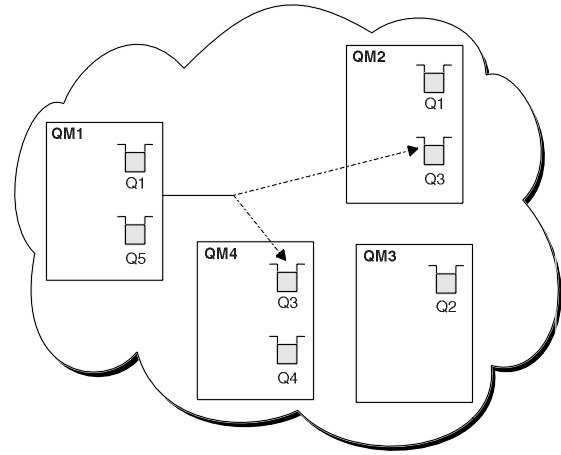Example of a cluster with more than one instance of a queue
In this example of a cluster with more than one instance of a queue, messages are routed to different instances of the queue. We can force a message to a specific instance of the queue, and we can choose to send a sequence of messages to one of either of the queue managers.
Figure 1 shows a cluster in which there is more than one definition for the queue Q3. If an application at QM1 puts a message to Q3, it does not necessarily know which instance of Q3 is going to process its message. If an application is running on QM2 or QM4, where there are local instances of Q3, the local instance of Q3 is opened by default. By setting the CLWLUSEQ queue attribute, the local instance of the queue can be treated the same as a remote instance of the queue.
The MQOPEN option DefBind controls whether the target queue manager is chosen when the MQOPEN call is issued, or when the message is transferred from the transmission queue.
If you set DefBind to MQBND_BIND_NOT_FIXED the message can be sent to an instance of the queue that is available when the message is transmitted. This avoids the following problems:- The target queue is unavailable when the message arrives at the target queue manager.
- The state of the queue has changed.
- The message has been put using a cluster queue alias, and no instance of the target queue exists on the queue manager where the instance of the cluster queue alias is defined.
If any if these problems are discovered at transmission time, another available instance of the target queue is sought and the message is rerouted. If no instances of the queue are available, the message is placed on the dead-letter queue.
One factor that can prevent messages being rerouted is if messages have been assigned to a fixed queue manager or channel with MQBND_BIND_ON_OPEN. Messages bound on MQOPEN are never reallocated to another channel. Note also that message reallocation only takes place when a cluster channel is actually failing. Reallocation does not occur if the channel has already failed.
The system attempts to reroute a message if the destination queue manager goes out of service. In so doing, it does not affect the integrity of the message by running the risk of losing it or by creating a duplicate. If a queue manager fails and leaves a message in doubt, that message is not rerouted.
On IBM MQ for z/OS, the channel does not completely stop until the message reallocation process is complete. Stopping the channel with mode set to FORCE or TERMINATE does interrupt the process, so if you do this then some BIND_NOT_FIXED messages might have already been reallocated to another channel, or the messages might be out of order.
Note:- Before setting up a cluster that has multiple instances of the same queue, ensure that your messages do not have dependencies on each other. For example, needing to be processed in a specific sequence or by the same queue manager.
- Make the definitions for different instances of the same queue identical. Otherwise you get different results from different MQINQ calls.
Parent topic: Use clusters for workload management
Related concepts
Related tasks
- Adding a queue manager that hosts a queue locally
- Use two networks in a cluster
- Use a primary and a secondary network in a cluster
- Adding a queue to act as a backup
- Restricting the number of channels used
- Adding a more powerful queue manager that hosts a queue